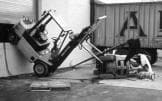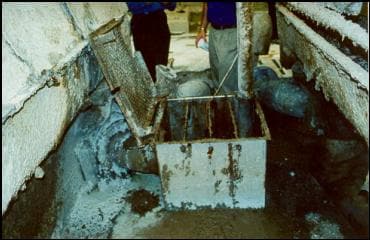Machine Operator Crushed in a Paper-Pulp Storage Tank
 |
 |
New Jersey FACE No. 99NJ062
SUMMARY
On July 21, 1999, a 54-year-old machine operator at a paper manufacturing plant was found dead in a paper pulp storage tank. No one saw the incident. The victim was discovered missing from his workstation near the chest and was found when the tank was drained to investigate a seized belt. Apparently the victim fell into the tank through a small access hatch, possibly as he stepped over the hatch to take a shortcut to his work area. NJ FACE investigators concluded that, to prevent similar incidents in the future, these safety guidelines should be followed:
- Employers should conduct a job hazard analysis of all work activities with the participation of the workers.
- Employers should develop, implement, and enforce a comprehensive employee safety program.
INTRODUCTION
On July 27, 1999, NJ FACE personnel were informed by a county medical examiner of a machine-related fatality that occurred on July 21, 1999. FACE investigators contacted the employer and conducted an investigation on August 11, 1999. During the site visit, FACE investigators met with company representatives before examining and photographing the incident site. Additional information on the incident was obtained from the OSHA investigation file, police report, and medical examiner’s report.
The employer was a paperboard manufacturing plant located in an urban area. In operation since 1903, this plant had been purchased in 1984 and modernized by the current owner. Changes included cleaning up the plant and investing in new equipment. The processes were also modified to use 100% recycled materials and discontinue adding chemicals to the paper. The employer stated that these changes greatly improved production while decreasing worker injuries. A safety program was also instituted that included safety training and regular safety meetings. Ninety-six employees worked at the plant in a three shift, 24 hour – 7 days per week operation. Employees were covered by a labor union.
The victim was a 54-year-old male Beater Engineer (beating machine operator) who had worked at the plant since May 1985. He started as a Chemical Mixer, then worked as a Slitting Machine Operator in 1987 before moving to his current position as Beater Engineer in 1989. His responsibilities included operating a paper mixer (beater) and testing the paper pulp fibers. He was born in Egypt, spoke English, and was married.
The victim had a significant medical history of heart disease and diabetes that may have possibly contributed to this incident. The employer stated that they accommodated his needs by moving him to the day shift, but were not fully aware of the extent of his condition.
INVESTIGATION
Background
The paperboard manufacturing process starts with the receipt of bales of recycled cardboard and paper at the plant. The bales are immersed in an agitation tank of 165° F water, breaking the paper down into fibers. The defibered paper or paper pulp is processed, separated by color, and temporarily stored in an underfloor “chest” (storage tank) where it circulates until needed. Pulp from the chest is pumped in a 4% solution to a paper machine that evenly distributes the pulp onto a fabric belt. Additional layers are added until the paper reaches the desired thickness, then it is run through a series of heated drying rolls. Starching, cutting, and rolling finish the paperboard process.
The victim’s work area was near a paper pulp chest that fed one of the paper machines. The hatchway to the chest is located between two large machines. Employees sometimes used this as a shortcut, climbing over some pipes and the hatchway to get by the machines. The hatchway measured 24 inches square and was raised 22 inches off the ground, with the chest underneath about twelve feet deep. A heavy metal grate was fitted to the hatchway. Paper pulp is pumped into the chest through a four-inch diameter pipe passing down through the hatchway. Inside the tile-lined chest was a propeller agitator that circulates the pulp. One of the victim’s responsibilities was to watch the chest and refill it when needed. Every 45 to 60 minutes he would throw a switch located about 30 feet from the hatch that activated the pump feeding the four-inch filler pipe. The pump was shut down when the chest was full, often when the operator saw pulp overflow the hatchway onto the floor. The victim also assisted with other processes around the plant.

Figure 1. Photo of paper pulp chest hatch (Safety bars were installed after the incident).
Incident
There were no witnesses to the incident. The victim was working the plant’s night shift that ran from 10:30 p.m. to 6:30 a.m. He had worked overtime for the past couple of weeks, including 56 hours the week prior to the incident. At about 11:40 p.m. he helped to fix a paper break in one of the paperboard machines. Fixing a break was hot and heavy work because of the heat from the rollers and the large size of the paper. The victim was reportedly described as pale and not looking well when he returned to the paper pulp chest, and was last seen by a foreman at 12:20 a.m. At about 1:40 a.m. a supervisor contacted the plant manager at home to say that they could not find the victim. The plant manager arrived at the plant to help search for the victim when someone smelled burning rubber from a seized belt on the chest agitator. Fearing that the victim had fallen in, they started to drain the chest and found a rubber boot blocking the drain. The plant manager called the police who were present as the remaining pulp was drained and the chest was entered and searched. The victim was found entangled around the agitator propeller and was pronounced dead at the scene. Fatal injuries included multiple impact and thermal injuries.
It is not known how or why the victim was in the chest. It is possible that the victim fell in as he walked over the open hatchway while taking a shortcut between the machines. He may have also fallen in while looking down or sitting on the edge of the hatchway. The victim’s medical condition and long working hours may have fatigued the victim and contributed to this incident.
RECOMMENDATIONS AND DISCUSSION
Recommendation #1: Employers should conduct a job hazard analysis of all work activities with the participation of the workers.
Discussion: It is not known how the victim fell into the paper pulp chest. However, several factors may have contributed to the incident, such as the hatchway being located in an area that could be used as a shortcut path. The surfaces in the area were also slippery from the wet paper pulp. To prevent incidents such as this, we recommend that employers conduct a job hazard analysis of all work areas and job tasks with the employees. A job hazard analysis should begin by reviewing the work activities that the employee is responsible for and the equipment needed. Each task is further examined for fall, electrical, chemical, or any other hazard the worker may encounter. The results of the analysis can be used to design or modify a written safety program. If employers are unable to do a proper job hazard analysis, they should hire a qualified safety consultant to do so.
Following this incident the employer installed metal bars across all the chest hatches to prevent unauthorized or accidental entry. The employer may want to consider installing railings near the machines and hatch to prevent it from being used as a shortcut.
Recommendation #2: Employers should develop, implement, and enforce a comprehensive employee safety program.
Discussion: FACE recommends that employers emphasize worker safety by developing, implementing, and enforcing a comprehensive safety program to eliminate or reduce hazardous situations. The safety program should include, but not be limited to, the recognition and avoidance of fall hazards and include appropriate worker training. The following sources of information may be helpful in developing a safety program and obtaining information on safety standards:
U.S. Department of Labor, OSHA
Federal OSHA will provide information on safety and health standards on request. OSHA also has several offices in New Jersey that cover the following areas:
Hunterdon, Middlesex, Somerset, Union, and Warren counties………………..(732) 750-4737
Essex, Hudson, Morris, and Sussex counties………………………………………….(973) 263-1003
Bergen and Passaic counties…………………………………………………………………(201) 288-1700
Atlantic, Burlington, Cape May, Camden, Cumberland, Gloucester,
Mercer, Monmouth, Ocean, and Salem counties……………………………………..(856) 757-5181
NJ Public Employees Occupational Safety and Health (PEOSH) Program
The PEOSH act covers all NJ state, county, and municipal employees. Two departments administer the act; the NJ Department of Labor (NJDOL) which investigates safety hazards, and the NJ Department of Health and Senior Services (NJDHSS) which investigates health hazards. Their telephone numbers are:
NJDOL, Office of Public Employees Safety …………………………………(609) 633-3896
NJDHSS, PEOSH Program…………………………………………………………(609) 984-1863
NJDOL Occupational Safety and Health On-Site Consultative Program
Located in the NJ Department of Labor, this program provides free advice to private businesses on improving safety and health in the workplace and complying with OSHA standards. For information on how to get a safety consultation, call (609) 292-0404, for a health consultation call (609) 984-0785. Requests may also be faxed to (609) 292-4409.
New Jersey State Safety Council
The NJ Safety Council provides a variety of courses on work-related safety. There is a charge for the seminars. Their address and telephone number is: NJ State Safety Council, 6 Commerce Drive, Cranford, NJ 07016, telephone (908) 272-7712
Internet Resources
Information and publications on safety and health standards can be easily obtained over the internet. Some useful sites include:
www.osha.govexternal icon – The US Department of Labor OSHA website.
www.cdc.gov/niosh/ – The CDC/NIOSH website.
www.state.nj.us/health/eoh/peoshweb/external icon – The NJDHSS PEOSH website. (Link updated 9/12/2005)
www.dol.gov/elaws/external icon – USDOL Employment Laws Assistance for Workers and Small Businesses.
To contact New Jersey State FACE program personnel regarding State-based FACE reports, please use information listed on the Contact Sheet on the NIOSH FACE web site. Please contact In-house FACE program personnel regarding In-house FACE reports and to gain assistance when State-FACE program personnel cannot be reached.
|
|
NJ Department of Health & Senior Services |
|
Back to New Jersey FACE reports
Back to NIOSH FACE Web
